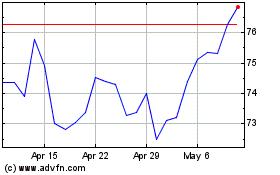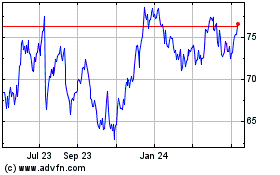Rating Cuts Threaten Big Banks - Analyst Blog
June 03 2011 - 12:44PM
Zacks
Will the government protect big banks any more? Will the "too
big to fail" presumption stick around anymore? The answers to these
questions will determine rating agencies’ actions on major U.S.
banks.
These perceptions may no longer hold true. At least, that’s what
the Dodd-Frank act clearly conveys. Ratings accorded by agencies
that were inflated assuming that mega banks are entitled to
government protection by default during a major financial crisis,
can now be downgraded.
First among the rating agencies, Moody's Investors Service, a
unit of Moody's Corp. (MCO), said on Thursday that
it is reviewing the ratings of three mega banks,Bank of
America Corp. (BAC), Citigroup Inc. (C)
and Wells Fargo & Co. (WFC) for possible
downgrades.
The agency had given strong investment-grade credit ratings to
these banks on the presumption of obvious government shelter.
However, now the agency is weighing the odds of government support
to these banks after the rules of Dodd-Frank financial act are put
into practice.
Currently, Bank of America, Citigroup and Wells Fargo
respectively hold Aa3, A1 and Aa2 from Moody’s. Without the
presupposition of government support, these ratings would have been
about three to five notches lower.
The reviewing process would take maximum three months. According
to the rating agency, the magnitude of downward rating revision
will be inversely proportional to the improvement of asset quality
and capital position of these banks by that time. As a result,
there will be normal ratings cushion like other small and medium
sized banks.
Then again, Moody’s does not entirely discount government
support to these banks. While the agency will definitely not rule
out government backing, it might tone down its stance to some
extent.
What would be the implication for banks if their credit ratings
are downgraded? Apart from losing out on investors’ confidence,
these banks would face high cost of borrowing. The reason is that
investors would invest in these low rated banks if they are
compensated for taking higher risk.
Apart from these three, five more banks enjoy higher ratings
from Moody's based on federal government support. These banks are
JPMorgan Chase & Co. (JPM), Goldman
Sachs Group Inc. (GS), Morgan Stanley
(MS), Bank of New York Mellon Corp. (BK) and
State Street Corp. (STT). Moody’s would target
these banks next for rating downgrades. The agency said that it has
already started evaluating its assumption of government support on
these banks.
To Conclude…
The unclear goals of the government bailout program strengthened
the perception that some big institutions are “too big to fail.”
Precisely, the lack of articulation ended up in a malformed
impression that Federal Reserve will always protect these
institutions from failing if they are in major financial
trouble.
Quite obviously, if the big institutions get the idea that a
bigger brother will be there to save them whenever they are in dire
straits, they will never hesitate to take extravagant risks.
Unfortunately, taxpayers will have to suffer by bearing the cost if
these institutions lose the gamble.
However, the Dodd-Frank act clearly conveys that if big
institutions dig their own holes by taking extravagant risks, they
would not get taxpayers’ assistance in future. As a result, rating
agencies are also keeping an eye on these banks. So, for these big
banks, the only way to exist is to do business without jeopardizing
the hard earned money of investors and taxpayers.
BANK OF AMER CP (BAC): Free Stock Analysis Report
BANK OF NY MELL (BK): Free Stock Analysis Report
CITIGROUP INC (C): Free Stock Analysis Report
GOLDMAN SACHS (GS): Free Stock Analysis Report
JPMORGAN CHASE (JPM): Free Stock Analysis Report
MOODYS CORP (MCO): Free Stock Analysis Report
MORGAN STANLEY (MS): Free Stock Analysis Report
STATE ST CORP (STT): Free Stock Analysis Report
WELLS FARGO-NEW (WFC): Free Stock Analysis Report
Zacks Investment Research
State Street (NYSE:STT)
Historical Stock Chart
From Jun 2024 to Jul 2024

State Street (NYSE:STT)
Historical Stock Chart
From Jul 2023 to Jul 2024
